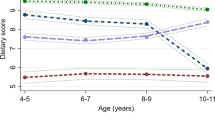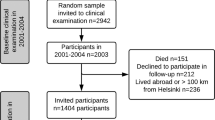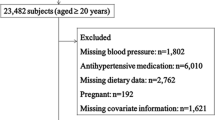Abstract
Extensive evidence exists that an inverse relation between education and blood pressure prevails in many adult populations, but little research has been carried out on reasons for this finding. A prior goal of the INTERMAP Study was to investigate this phenomenon further, and to assess the role of dietary factors in accounting for it. Of the 4680 men and women aged 40–59 years, from 17 diverse population samples in Japan, People's Republic of China, UK, and USA, a strong significant inverse education–BP relation was manifest particularly for the 2195 USA participants, independent of ethnicity. With participants stratified by years of education, and assessment of 100+ dietary variables from four 24-h dietary recalls and two 24-h urine collections/person, graded relationships were found between education and intake of many macro- and micronutrients, electrolytes, fibre, and body mass index (BMI). In multiple linear regression analyses with systolic BP (SBP) and diastolic BP (DBP) of individuals the dependent variables (controlled for ethnicity, other possible nondietary confounders), BMI markedly reduced size of education–BP relations, more so for women than for men. Several nutrients considered singly further decreased size of this association by ⩾10%: urinary 24-h Na and K excretion, Keys dietary lipid score, vegetable protein, fibre, vitamins C and B6, thiamin, riboflavin, folate, calcium, magnesium, and iron. Combinations of these dietary variables and BMI attenuated the education–SBP inverse coefficient by 54–58%, and the education–DBP inverse coefficient by 59–67%, with over half these effects attributable to specific nutrients (independent of BMI). As a result, the inverse education–BP coefficients ceased to be statistically significant. Multiple specific dietary factors together with body mass largely account for the more adverse BP levels of less educated than more educated Americans. Special efforts to improve eating patterns of less educated strata can contribute importantly to overcoming this and related health disparities in the population.
This is a preview of subscription content, access via your institution
Access options
Subscribe to this journal
Receive 12 digital issues and online access to articles
$119.00 per year
only $9.92 per issue
Buy this article
- Purchase on Springer Link
- Instant access to full article PDF
Prices may be subject to local taxes which are calculated during checkout
Similar content being viewed by others
References
Dyer A, Stamler J, Shekelle R, Schoenberger J . The relationship of education to blood pressure. Circulation 1976; 54: 987–992.
Klatsky A, Friedman G, Siegelaub A, Gerard M . Alcohol consumption and blood pressure. N Engl J Med 1977; 296: 1194–1200.
Liu K et al. Relationship of education to major risk factors and death from coronary heart disease, cardiovascular diseases and all causes: findings of three Chicago epidemiologic studies. Circulation 1982; 66: 1308–1314.
Hypertension Detection and Follow-Up Program Cooperative Group. Educational level and 5-year all-cause mortality in the Hypertension Detection and Follow-Up Program. Hypertension 1987; 9: 641–646.
Sorel JE, Ragland DR, Syme SL, Davis WB . Educational status and blood pressure: The Second National Health and Nutrition Examination Survey, 1976–1980, and the Hispanic Health and Nutrition Examination Survey, 1982–1984. Am J Epidemiol 1992; 135: 1339–1348.
Winkleby MA, Fortmann SP, Rockhill B . Trends in cardiovascular disease risk factors by educational level: The Stanford Five-City Project. Prev Med 1992; 21: 592–601.
Pekkanen J et al. Coronary risk factor levels: differences between educational groups in 1972–87 in eastern Finland. J Epidemiol Community Health 1995; 49: 144–149.
Stamler J et al. Socioeconomic status, cardiovascular risk factors, and cardiovascular disease: findings on U.S. working populations. Report of the Conference on Socioeconomic Status and Cardiovascular Health and Disease; 1995 Nov 6–7, National Institutes of Health, National Heart, Lung, and Blood Institute, 1996, pp 109–118.
Kaplan GA, Keil JE . Socioeconomic factors and cardiovascular disease: a review of the literature. Circulation 1993; 88: 1973–1998.
Colhoun HM, Hemingway H, Poulter NR . Socio-economic status and blood pressure: an overview analysis. J Hum Hypertens 1998; 12: 91–110.
Pickering TG . The effects of environmental and lifestyle factors on blood pressure and the intermediary role of the sympathetic nervous system. J Hum Hypertens 1997; 11(Supp 1): S9–S18.
Pickering T . Cardiovascular pathways: socioeconomic status and stress effects on hypertension and cardiovascular function. Ann NY Acad Sci 1999; 896: 262–277.
Steptoe A, Marmot M . The role of psychobiological pathways in socio-economic inequalities in cardiovascular disease risk. Eur Heart J 2002; 23: 13–25.
Dyer AR et al. Ten-year incidence of elevated blood pressure and its predictors: the CARDIA Study. J Hum Hypertens 1999; 13: 13–21.
Stamler J et al. Eight-year blood pressure change in middle-aged men: relationship to multiple nutrients. Hypertension 2002; 39: 1000–1006.
Stamler R et al, on behalf of the INTERSALT Cooperative Research Group. Higher blood pressure in adults with less education: some explanations from INTERSALT. Hypertension 1992; 19: 237–241.
Stamler J et al, for the INTERMAP Research Group. INTERMAP: background, aims, design, methods, and descriptive statistics (non-dietary). J Hum Hypertens 2003; 17: 591–608.
Dennis B et al, for the INTERMAP Research Group. INTERMAP: the dietary data—process and quality control. J Hum Hypertens 2003; 17: 609–622.
Ganguli MC et al. Higher education and income are related to a better Na : K ratio in blacks: baseline results of the Treatment of Mild Hypertension Study (TOMHS) data. Am J Hypertens 1997; 10: 979–984.
Appel LJ et al, for the DASH Collaborative Research Group. A clinical trial of the effects of dietary patterns on blood pressure. N Engl J Med 1997; 336: 1117–1124.
Sacks FM et al, for the DASH–Sodium Collaborative Research Group. Effects on blood pressure of reduced sodium and the Dietary Approaches to Stop Hypertension (DASH) diet. N Engl J Med 2001; 344: 3–10.
US Department of Health and Human Services. Healthy People 2010: Understanding and Improving Health, 2nd edn. US Government Printing Office: Washington, DC, November 2000.
Acknowledgements
The INTERMAP study has been supported by Grant 2-RO1-HL50490 from the US National Heart, Lung, and Blood Institute, National Institutes of Health, Bethesda, MD, USA; by the Chicago Health Research Foundation; and by national agencies in Japan (the Ministry of Education, Science, Sports, and Culture, Grant-in-Aid for Scientific Research [A] No. 090357003) People's Republic of China, and the United Kingdom. It is a pleasure for us to express appreciation for fine contributions of many colleagues at INTERMAP research facilities in Belgium, Japan, PRC, UK, and USA; for a listing of these facilities and many of the co-workers at each of these centres, see Stamler et al.17
Author information
Authors and Affiliations
Consortia
Corresponding author
Rights and permissions
About this article
Cite this article
Stamler, J., Elliott, P., Appel, L. et al. Higher blood pressure in middle-aged American adults with less education—role of multiple dietary factors: The INTERMAP Study. J Hum Hypertens 17, 655–664 (2003). https://doi.org/10.1038/sj.jhh.1001608
Published:
Issue Date:
DOI: https://doi.org/10.1038/sj.jhh.1001608
Keywords
This article is cited by
-
Gene-educational attainment interactions in a multi-ancestry genome-wide meta-analysis identify novel blood pressure loci
Molecular Psychiatry (2021)
-
Factors associated with intra-individual visit-to-visit variability of blood pressure in four countries: the INTERMAP study
Journal of Human Hypertension (2019)
-
Population-based prevalence of high blood pressure among adults in an urban slum in Enugu, South East Nigeria
Journal of Human Hypertension (2016)
-
The Application of Metabonomics to Predict Drug-Induced Liver Injury
Clinical Pharmacology & Therapeutics (2010)
-
Population based prevalence of high blood pressure among adults in Addis Ababa: uncovering a silent epidemic
BMC Cardiovascular Disorders (2009)



